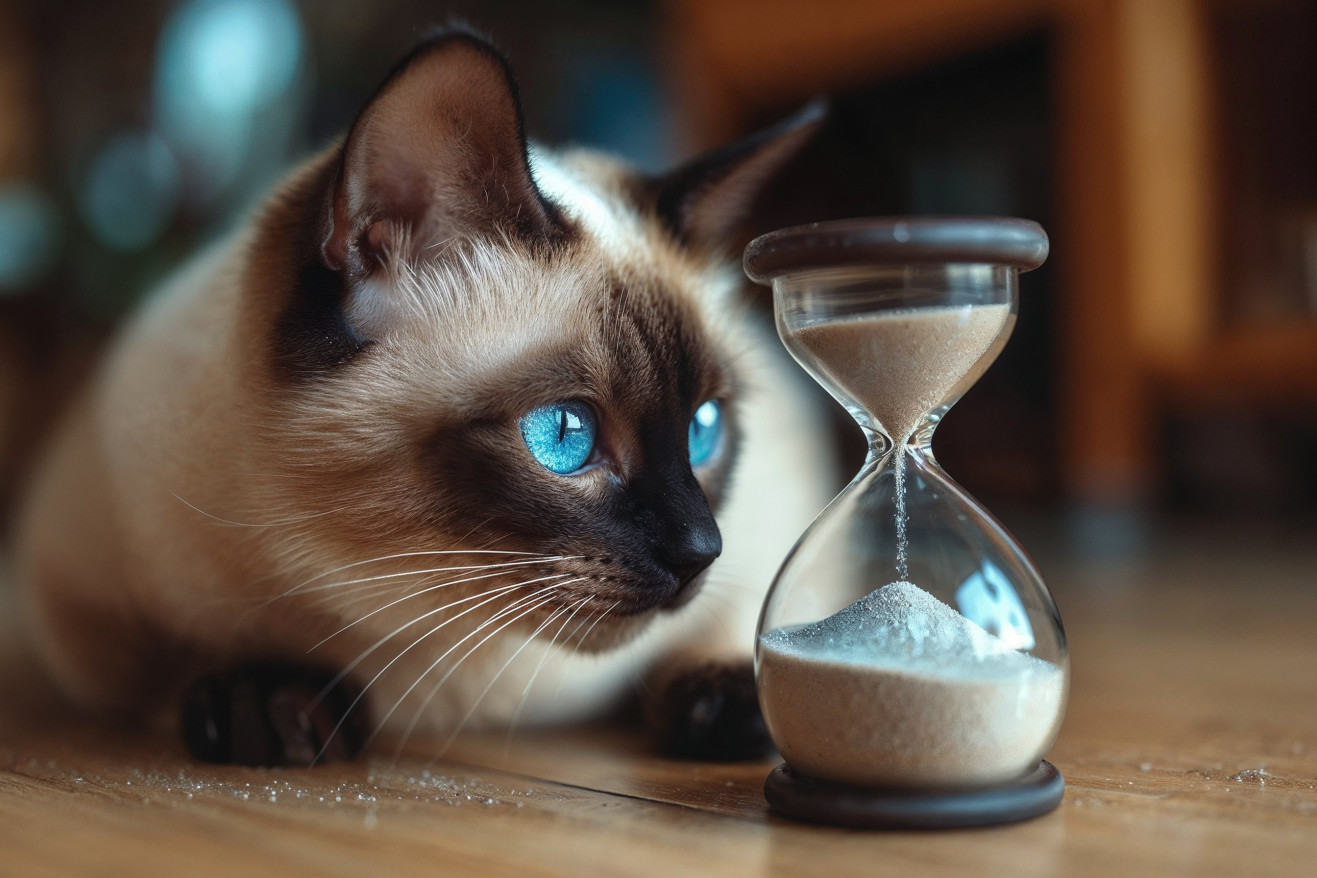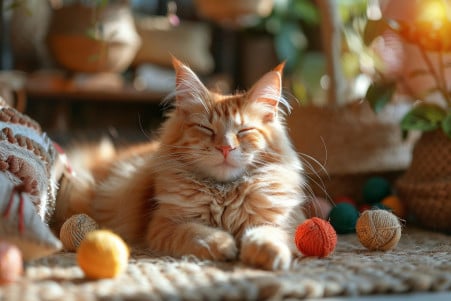Can Cats Tell Time? How Cats Perceive Time
31 January 2024 • Updated 6 February 2024

You’re getting ready to feed your cat, and right on time, they start meowing at you. Is this just a coincidence, or do cats have a sense of time? While cats can’t tell time in the way that humans can, they do have a sense of time, especially when it comes to understanding daily schedules and other environmental factors like when they’re going to be fed.
Cats can also tell time based on the position of the sun and the schedules of their human family members, but their ability to do so is less accurate than that of humans.
In the sections below, we will review a wide range of behavioral, neuroscientific, and comparative research in the field of animal cognition. By drawing on these interdisciplinary studies, we will investigate how domestic cats perceive time through their daily schedules, their responses to environmental factors, and the potential neurological processes that may be involved in their sense of time.
Understanding this research will not only answer your questions but also help you better understand and meet your cat’s needs.
Can cats tell time?
Chronobiology of Cats: The Role of Schedule and Environment
A study in ScienceDirect found that cats have a wide range of activity patterns that are influenced by their living situations.
Cats that live in smaller spaces and have regular human contact are more active during the day, which means their activity patterns are in sync with their human owners.
On the other hand, cats that have more access to the outdoors and less human contact are more active at night, which shows that cats are able to adapt to different environments. This study shows how much human contact and the structure of domestic life can affect a cat’s daily rhythms.
Having a regular schedule is also very important to a cat’s sense of time. The Cat Bandit Blog says that regular feeding and play schedules can help cats develop a consistent sense of time, and they can also help cats feel more secure and safe.
In addition, Floppycats says that changes in schedule can lead to stress and behavioral problems in cats, and that cat owners should be aware of the signs of stress and help their cats through any changes. The importance of a regular schedule to a cat’s well-being is clear, as it helps create a stable and predictable environment that cats need to feel safe.
These studies show that it’s important to understand the details of how cats perceive time and how that can be used to help create a better environment for them.
Understanding Cats’ Circadian Rhythms
The cat’s daily sleep–wake patterns and the timing of their activities are all influenced by their circadian rhythms, which are daily biological cycles that are regulated by the light–dark cycle in the environment.
A study in PubMed found that in cats, the daily changes in sleep time and brain temperature are in sync with the light-dark cycle in the environment, suggesting that cats have a well-developed circadian timing system that is sensitive to changes in natural light and can be entrained by it.
A study in PMC discusses the general concept of interval timing, an internal timing mechanism that acts like an internal clock and is found in many species. While the study doesn’t focus on cats, the idea of interval timing may help explain why certain cat behaviors, such as hunting, are triggered by internally timed intervals rather than external cues.
The same PMC study suggests that if the neurobiological basis of time perception is better understood, it may help explain how these processes work in cats. This, in turn, could help people better understand cats’ perception of time and intervals, which could help people interact with cats more effectively and even help people better design cats’ environments to better meet their needs.
This research also helps build a more complete picture of cats as animals that are sensitive to the nuances of time, and it may help researchers better understand how cats’ time perception compares to that of other animals.
How Cats’ Time Perception Compares to Other Animals
When it comes to time perception, cats may have more in common with birds and flies than with turtles or whales. A study in Animal Behaviour found that animals with faster metabolic rates, like small birds, perceive time differently than animals with slower metabolic rates. This would mean that cats, with their small size and fast metabolism, perceive time with more detail, which would help them with hunting.
The idea of critical flicker fusion frequency, or the point at which faster flicker rates are seen as a constant light, is directly tied to an animal’s pace of life. According to Scientific American, animals that can see higher flicker frequencies perceive the world in slow motion. Cats, with their high flicker frequency, likely see fast movements in more detail, which would help them with their crepuscular hunting during the twilight hours.
This has important ecological implications, as each animal’s perception of time, which is honed by their relationship with their environment, impacts their survival and other aspects of their lives.
When comparing cats’ time perception to other domesticated animals, it’s likely that while their perception isn’t unique, it is definitely specialized to their ecological niche and lifestyle. This specialized perception is what enables the complex behaviors that we see in domesticated cats and shows just how complex their relationship with the world around them really is.
How to Improve Your Cat’s Quality of Life Based on Their Time Perception
By understanding how your cat perceives time, you can help improve their quality of life. One of the best ways to do this is to create an environment that is conducive to their time perception. This means that you should create a routine that is based on their natural circadian rhythm. This will help them feel safe and secure.
International Cat Care explains that regular play and feeding times are important for a cat’s physical and mental well-being. This will also help them feel more comfortable when changes occur because they will know what to expect at certain times of the day.
If you do need to make changes, make sure that you do so gradually. This will help your cat adjust to the changes without feeling stressed. You can also help your cat by incorporating them into your routine. For example, if you play with them before work or snuggle with them at the same time every night, this will help them feel more secure and comfortable.
A-Z Animals also explains that you should watch for signs of stress in your cat, such as changes in behavior or eating habits, and make changes as needed. If you notice these signs, you should talk to your vet and consider environmental enrichment to help your cat feel more comfortable.
This can include things like new toys, scratching posts, or interactive feeders. This will help keep them entertained and engaged, especially when you’re not home, so that they feel less stressed during their alone time.
Pondering the Cat Clock: What We Know About How Cats Perceive Time
Our exploration of how cats perceive time leads us to the conclusion that cats do, in fact, have a sense of time that is guided by their internal clocks and daily routines. Evidence from Cats.com and Catster shows that cats develop routines and behaviors that demonstrate an awareness of the structure of the day through their circadian rhythms and responses to environmental stimuli.
Meanwhile, a Northwestern University study, as reported by ScienceDaily, backs up the idea that cats’ sense of time is based on neurological factors, providing a scientific basis for our observations.
The importance of routines in cats’ lives is shown to be a key part of their well-being, with changes in routines potentially leading to stress, as Cats.com points out. This makes it important to set and stick to regular schedules to ensure the health and happiness of cats.
Meanwhile, for cat owners, understanding and meeting their cats’ time-based needs is important for strengthening the human-cat bond and making sure that everyone in the household is happy.
While the current research has provided a lot of insight into the topic, the mystery of how cats perceive time leaves plenty of room for future study. A better understanding of how cats perceive time will help us deepen our relationships with these fascinating animals and lead to better care and understanding of our feline companions.


